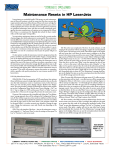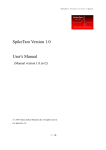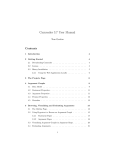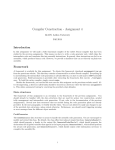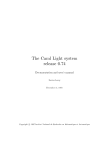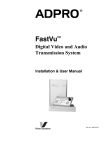Download A beginning user manual for clj-peg
Transcript
A beginning user manual for clj-peg
Richard Lyman
www.lithinos.com
This documentation was written for version 0.6
This manual is written for those who are comfortable developing in Clojure, and who may or may not be comfortable
with parsing, lexing, or grammar construction. You should
not need to have an advanced degree to understand this manual.
I have written each section as tightly as I could, providing for shorter and more numerous sections. If you’re unsure where to start, simply start reading from the very beginning and continue. Each section will flow into the next and
should progress nicely. If there are parts where my explanations leave you confused, please let me know.
If you’re familiar with terms such as AST or non-greedy
consumption you should skip along on the section titles and
skim the code until you find something new. If there are parts
that you find ambiguous, please let me know.
Either way, I hope this manual helps you to get up to speed
as quickly as you want. I also hope that you become effective in using the clj-peg library and that that effectiveness will
encourage you to share your PEGs with others.
{:A
[
(
{:B "b"}
{:B "b"}
{:B "b"}
)
{:Empty true}
]
}
Listing 2: The result of applying the parser generated from the
grammar in Listing 1 on the input “bbb”
Setup
To start getting our hands dirty with clj-peg we’ll need to
install it. There really isn’t much to installing clj-peg, just
download it2 , extract it, and put the JAR file on your classpath. For a more complete walkthrough on setting up a Clojure project, I wrote a post with details on my typical setup.
Using that typical setup, I’d place the clj-peg.jar file in the
dst/lib folder.
After the clj-peg JAR is on the classpath, you can use the
library in several ways. For this manual, we’ll be including
code through the :use reference in the ns macro. Our main
file will look like Listing 3 to begin with.
Overview
When you create a PEG you create a set of functions that
are able to parse input. The specific pattern of input that those
functions parse is defined in the rules of the PEG you create1 .
Starting with a PEG as defined in Listing 1, we can use the
functions it creates to process the input “bbb” as a String.
This PEG accepts a string with one or more b’s and nothing
else.
(ns com.company.project.main
(:gen-class)
(:use (com.lithinos.clj-peg
core
string-peg)))
(make-parser {
:main
simple-parser
:doc
"This is a simple grammar."
:rules (
A <- [(+ B) $]
B <- "b")})
(defn -main [& args]
(println "Works"))
Listing 3: Using clj-peg code
For help with the commands to compile and run a Clojure application, I’d again refer you to my post with details
on my typical setup that includes very simple Ant scripts.
You should easily be able to understand what needs to happen
when compiling or running a Clojure application, and should
easily be able to integrate that process into your own build
approach if you choose to not use those Ant scripts.
Listing 1: A simple PEG defined in clj-peg
When the newly created functions have finished processing the input “bbb”, they return a structure that describes the
input, and this is traditionally referred to as an AST (Abstract
Syntax Tree). This result of parsing the input is shown in Listing 2. You can see that the data structures used in the result
closely match the data structures used in the grammar.
The way the macro make-parser works allows you to treat
a grammar definition like any other data structure. If you
share your grammar, I’d recommend simply tying it to some
symbol using def, and allowing those who use it to eval
the related symbol. This gives your users the opportunity of
tweaking your grammar to fit their needs. There are more
details about the process of tweaking a grammar in later sections.
Examples
I’m going to provide some examples in the following sections, but there are a few explanations that come first. In any
clj-peg definition, the three items to notice are the main function, the doc string, and the rules. The main function is set
to math, which is what you’ll call to use the parser. The doc
string is what accompanies the resulting main function. The
rules, commonly referred to as productions, define the different non-terminals and terminals as well as how they’re joined
to form all of the possible combinations of input that can be
parsed.
1
Note that I’m making a distinction between input pattern and input type.
While the pattern of input that can be processed is defined as shown in Listing
1, the type is not necessarily defined. Specifically, clj-peg doesn’t care what
type of input you provide since it must be wrapped in a specific type of struct.
That specific type of struct acts as an interface between the generated parsing
code and some input type.
2 Depending
1
on your intended use, you may need to purchase a license.
Sequence [A B] The parser must consume A first,
and that must be followed by consuming B.
{:Expr [
{:Sum [
{:Value {:Num "1"}}
(
[{:SumOp "+"} {:Value {:Num "2"}}]
[{:SumOp "-"} {:Value {:Num "3"}}]
)
]}
{:Empty true}
]}
Ordered choice (| A B) The parser must either consume A
or B, and the parser must try A first,
followed by trying B.
Zero or more (* A) The parser must greedily consume
zero or more of A.
Listing 4: The AST from the grammar in Listing 5 applied to
”1+2-3”
One or more (+ A) The parser must greedily consume
at least one, and will greedily consume more than one of A if it can.
One or none (? A) The parser must consume one of A
if it can.
won’t bother with Empty, since, in this case, it doesn’t matter.
The non-terminals SumOp and Num are easily handled inside
Value and Sum. The complete code is shown in Listing 5.
And predicate (& A) The parser must be able to consume A and must not consume A.
(ns com.company.project.main
(:gen-class)
(:use (com.lithinos.clj-peg
core
string-peg)))
Not predicate (! A) The parser must not be able to consume A.
Table 1: Operators and delimiters for combining non-terminals
and terminals in a clj-peg definition.
(def g ’(make-parser {
:main math
:doc "The characters +, and - are the only
operators, and positive whole integers
are the only operands."
:rules (
Expr <- [Sum $]
Sum
<- [Value (* [SumOp Value])]
Value <- (| Num Expr)
Num
<- #"ˆ[0-9]+"
SumOp <- #"ˆ[+-]")}))
Rules, in clj-peg, use operators and delimiters to combine
non-terminals. If you are familiar with PEG grammars in general, you’ll find that these fit the basic definition. All of the
provided combinations are shown in Table 1. These delimiters and operators follow Clojure data structures and function
calls.
(declare Expr-interpreter)
Simple Example
(defn Value-interpreter [ast]
(let [ast (ast :Value)]
(if (contains? ast :Expr)
(Expr-interpreter ast)
(Integer/parseInt (ast :Num)))))
We’re going to be developing a grammar that parses simple
mathematical operations. For now we’ll only support positive
whole integers as operands, and we’ll only support addition
and subtraction as operators. The entire result3 can be seen in
Listing 5, so let’s look at the grammar tied to the symbol g.
In this specific definition, the non-terminals are Expr, Sum,
and Value and the terminals are Num, and SumOp. Notice use
of the Clojure reader macro for Patterns in the terminals Num,
and SumOp. Currently, non-terminals can be anything that is
seqable but is not a String, the rest can be used in terminals.
Writing an interpreter for this simple grammar is fairly
easy. Each non-terminal that is part of an AST has the form
{:Non-Terminal <body>}. There is only one key/value pair
in the map, the key will be based on the non-terminal, and
the body will match the grammar in structure and use of RHS
combinations. Let’s look at the result from the grammar in
Listing 5 and apply it to the expression “1+2-3”. The resulting AST is shown in Listing 4.
Interpreting this AST can be approached by defining a
function for selected non-terminals. We’ll define functions
for the non-terminal mappings Expr, Sum, and Value. We
(defn Sum-interpreter [ast]
(let [ast (ast :Sum)]
(reduce
(fn [a b]
(let [rater ((first b) :SumOp)
rand (Value-interpreter (second b))]
(if (= rater "+")
(+ a rand)
(- a rand))))
(Value-interpreter (first ast))
(second ast))))
(defn Expr-interpreter [ast]
(Sum-interpreter (first (ast :Expr))))
(eval g)
(defn -main [& args]
(let [input "1+2-3"
valid-struct (create-string-input input)
ast
(math valid-struct)
answer
(Expr-interpreter ast)]
(println input "=" answer)))
3 If we were to distribute this code we would not use :gen-class, or
have a main method, or call eval on the grammar.
Listing 5: A simple example
2
Advanced Example
(reduce
sum-reduction
(Product-interpreter (first ast))
(second ast)))))
Let’s extend the simple example with a few changes. We’ll
be allowing multiplication, and division, and we’ll do so in a
way that preserves the required precedence. There isn’t anything too difficult with these changes.
We’ll also be expanding the definition of what numbers are
allowed by re-using part of a JSON grammar. This change is
important, since it can show how simple it is to mix and match
parts of grammars. You can notice that the changes to re-use
part of a JSON grammar are even easier than the changes to
allow multiplication and division.
(defn math-interpreter [ast]
(Sum-interpreter (first (ast :Expr))))
(eval json-grammar)
(eval math-grammar)
(defn -main [& args]
(let [input "1.2*3.4+5"
valid-struct (create-string-input input)
ast
(math valid-struct)
answer
(math-interpreter ast)]
(println input "=" answer)))
(ns com.company.project.main
(:gen-class)
(:use (com.lithinos.clj-peg core string-peg
json-parser json-interpreter)))
Listing 6: An advanced example
The additions for multiplication and division are simple. The non-terminal Product becomes similar to what Sum
was, and placing Product below Sum in the AST allows our
bottom-up interpreter the opportunity of solving products before sums. You can see, as well, that the interpreter for the
new Product non-terminal is very similar to the interpreter
for Sum.
The interesting part, however, is the extension of our math
grammar to include JSONNumbers. Even though the implementation of the JSONNumber interpreter is not complete, our simple use of it in this case will still work. For
the first step, we need to import the json-interpreter
and json-parser namespaces. Second, we reference the
JSONNumber non-terminal in our math grammar. Third we
evaluate the json-grammar before we evaluate our grammar, so that the definition for JSONNumber is available when
we evaluate our grammar. Fourth, and finally, we call the
JSONNumber-interpreter inside our Num-interpreter.
(def math-grammar ’(make-parser {
:main math
:doc "The characters +, -, *, and / are the
only operators, and JSONNumbers are
the only operands."
:rules (
Expr
<- [Sum $]
Sum
<- [Product (* [SumOp Product])]
Product
<- [Value (* [ProductOp Value])]
Value
<- (| Num Expr)
Num
<- JSONNumber
SumOp
<- #"ˆ[+-]"
ProductOp <- #"ˆ[*/]")}))
(declare Expr-interpreter)
(defn Num-interpreter [ast]
(JSONNumber-interpreter (ast :Num)))
(defn Value-interpreter [ast]
(let [ast (ast :Value)]
(if (contains? ast :Expr)
(Expr-interpreter ast)
(Num-interpreter ast))))
Conclusion
(defn product-reduction [a b]
(let [temp-op ((first b) :ProductOp)
operator (if (= temp-op "*") * /)
operand1 a
operand2 (Value-interpreter (second b))]
(operator operand1 operand2)))
I need to write another manual. This one does not cover
everything. You’ve likely noticed that there were things that I
didn’t explain, such as the create-string-input function. In addition, there are several parts of the clj-peg library that aren’t
finalized in my mind. These will all require at least one more
manual.
For now, this manual is sufficient to scratch my documentation itch. I have too many projects all running along at the
same time, and this is just one of them. It was bumped to
the front of the queue since I’m using it in other projects that
were themselves at the front.
There are some issues that I want to address before the 0.8
and 1.0 releases, but I’m hoping that they’re all internal. As a
consequence of that, I’m also hoping that this documentation
will only minimally change as clj-peg moves toward a 1.0
release. I’m still open to feedback, but at version 0.6, the
details are starting to solidify. Please contact me if you have
anything that I can help with. While I don’t pretend to have
as much time as I’m filling, I do try to care.
Good luck and don’t be afraid to share your grammars.
(defn Product-interpreter [ast]
(let [ast (ast :Product)]
(if (contains? (second ast) :Zero-or-more)
(Value-interpreter (first ast))
(reduce
product-reduction
(Value-interpreter (first ast))
(second ast)))))
(defn sum-reduction [a b]
(let [temp-op ((first b) :SumOp)
operator (if (= temp-op "+") + -)
operand1 a
operand2 (Product-interpreter (second b))]
(operator operand1 operand2)))
(defn Sum-interpreter [ast]
(let [ast (ast :Sum)]
(if (contains? (second ast) :Zero-or-more)
(Product-interpreter (first ast))
3




